What is Headless Commerce? The Ultimate Guide for Retailers
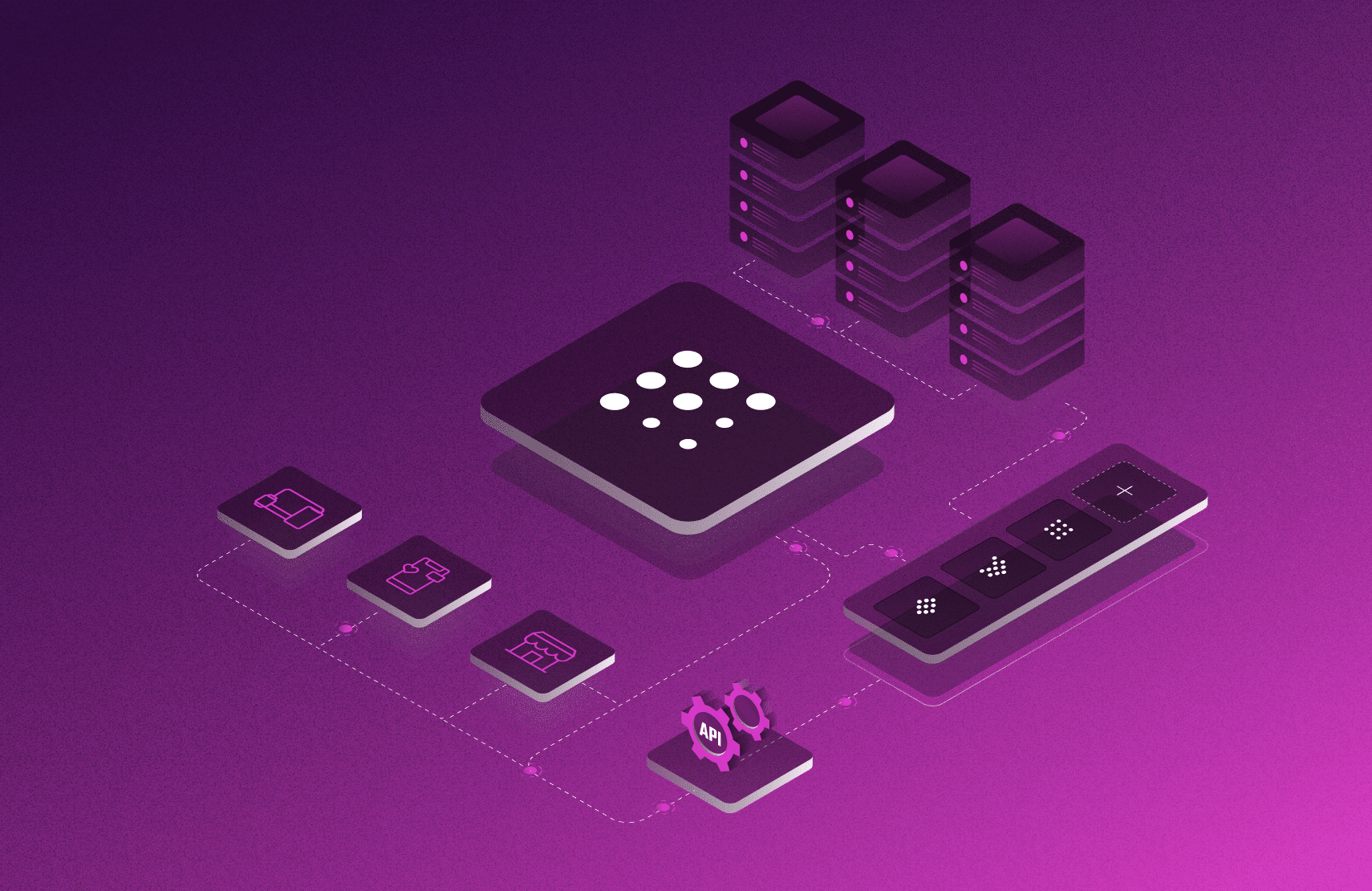
Changing consumer trends require retailers to adopt technologies that provide a consistent customer journey across sales channels.
Headless commerce complements modularity to enable brands to scale efficiently and without incurring significant technical debt.
fabric Commerce Platform is a powerful and versatile modular commerce platform that provides retailers with a scalable out-of-the-box commerce experience.
Modern e-commerce is continually changing, spurred, in part, by shifting consumer trends. Before the ubiquity of mobile devices like smartphones and tablets, the success of e-commerce hinged on consumers’ access to personal computers.
Today, 66% of online shoppers use smartphones to make e-commerce purchases, compared to 41% who use laptops and 25% who use desktop PCs. According to Insider Intelligence, mobile e-commerce sales are expected to account for 40.4% of retail e-commerce sales in the U.S. by 2024.
These trends precipitate a need for e-commerce retailers to further adapt and evolve if they hope to secure this growing market. Headless commerce lets brands deliver seamless experiences across sales channels, providing a consistent customer journey regardless of where and how a customer embarks upon it.
Using headless commerce means brands can fine-tune the sales journey on PC, mobile, in-app, through physical kiosks, and elsewhere. At the same time, customers aren’t penalized for their preferences; the same information available to them via desktop is available in your branded mobile app, providing a streamlined experience across the board.
Adopting headless and modular commerce helps brands reduce the total cost of ownership (TCO) and improves flexibility, functionality, and scalability.
What is Headless Commerce?
Headless commerce is an e-commerce approach that decouples the frontend customer experience from the backend commerce functionality, allowing businesses to create highly customizable and unique shopping experiences across various digital channels.
It lets brands present different or customized presentation layers — the frontend — while maintaining backend systems responsible for managing order, products, transactions, and data independently. This means brands can differentiate the customer experience from channel to channel to create a consistent experience where desired and differentiation when needed.
Why is headless commerce important?
Changing consumer trends highlight the importance of omnichannel retail initiatives. But embracing omnichannel without a clear idea of how to implement it can diminish its value and contribute to a brand’s TCO. A headless commerce architecture lets brands adopt, deploy, and scale an omnichannel sales approach without incurring significant technical debt.
Headless Commerce 101: Everything You Need To Know
Headless e-commerce might sound like a new concept, but the term was initially coined in 2013 by Dirk Hoering to describe separating “single-head ‘suite’ platforms from this new ‘multi-headed’ approach”. In short, the headless commerce definition outlines a shift from commerce-led platforms — monoliths like Salesforce Demandware, Oracle ATG, and Shopify — to a content-led approach based around a content management system (CMS).
By separating the frontend and backend using a headless CMS, retailers can optimize the same content across devices and channels, using application programming interfaces (APIs) to sync the data between the CMS (the frontend) and e-commerce functionality (such as the cart, inventory, and other backend services).
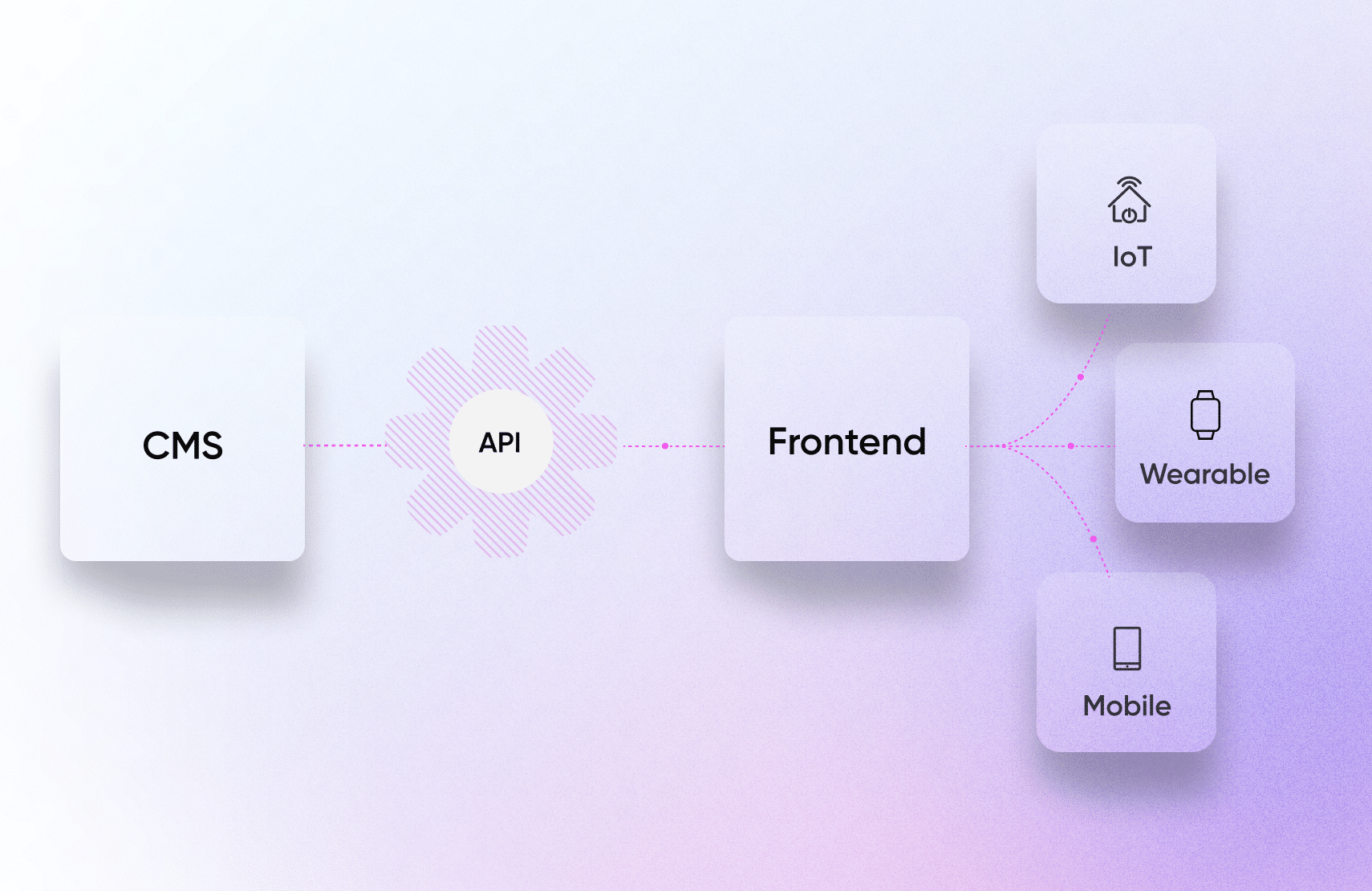
By separating the frontend and backend using a headless CMS, retailers can optimize the same content across devices and channels.
How headless commerce works
In a headless commerce architecture, the frontend — or presentation layer — is decoupled from the backend — which handles business logic and commerce services. APIs facilitate communication between the frontend and backend, pulling information from the latter and displaying it on the former.
A typical headless commerce architecture involves several elements:
Backend systems are the individual components or modules that collect, handle, and manage data and information. Backend systems include modules like cart and checkout, customer relationship management (CRM), inventory management, order management system (OMS), pricing and promotions, and product information management (PIM).
APIs allow applications and services to communicate with one another, even if those applications use different frameworks. This liberates developers from using a single technology or programming language to develop applications. In a headless commerce solution, APIs push information from the backend to the frontend whenever a request is made. API orchestration is the process of integrating and coordinating multiple APIs from different sources into a single, coherent system.
A headless CMS centralizes and manages content on the backend. Where a traditional CMS combines content and display layers, a headless CMS feeds content to different frontend displays via APIs. This lets developers design unique and device-specific displays for each sales channel while tapping into the same content shared with other frontend touchpoints.
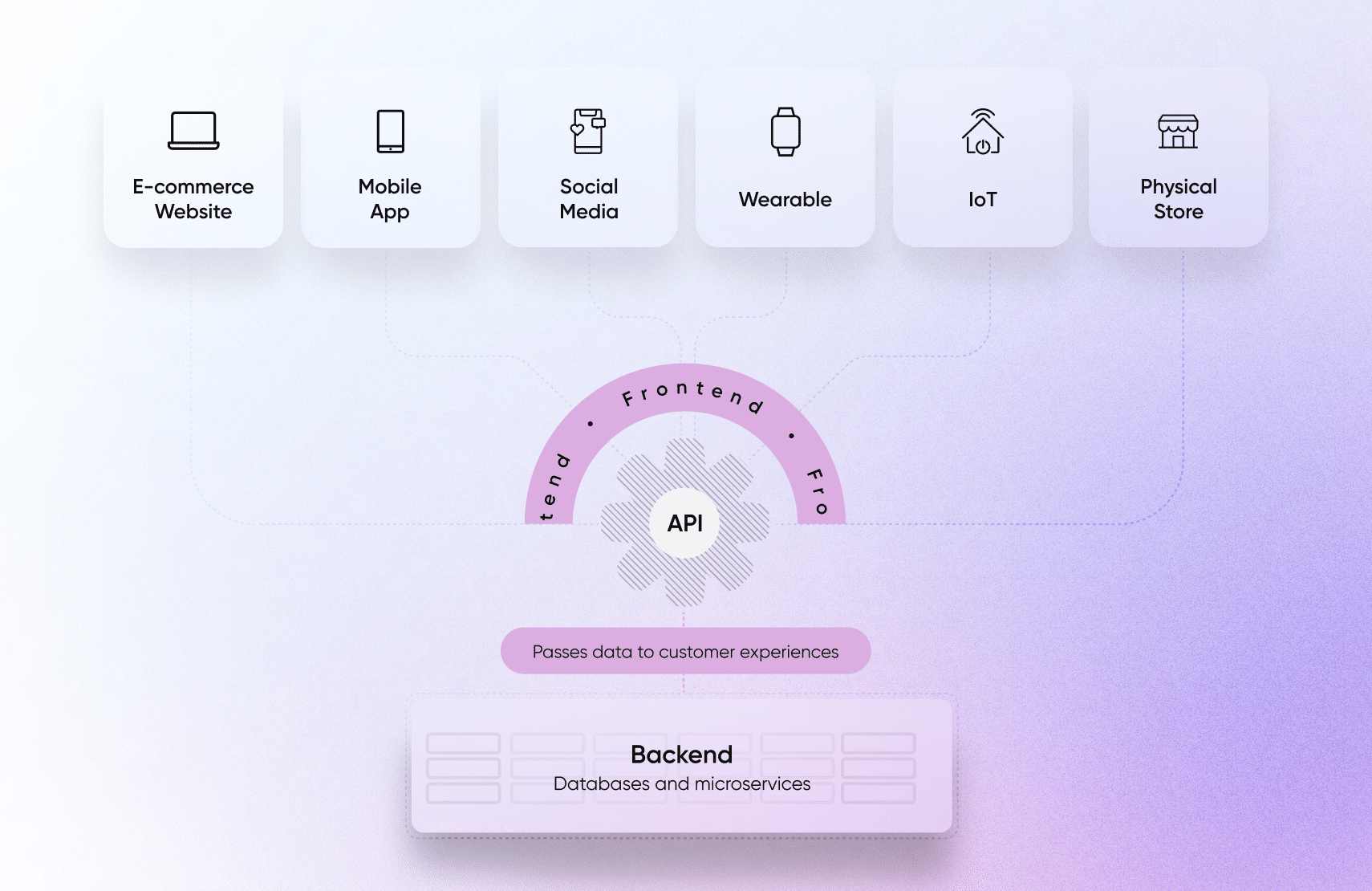
In a traditional CMS, the content layers and display layers are combined. In a headless CMS content is fed to different frontend displays via APIs.
Types of Headless Commerce
The term “headless commerce” is often used interchangeably with “modular commerce” and “composable commerce.” Though each concept shares similarities — and a basis in headless commerce overall — they’re distinct from one another.
Modular commerce involves breaking down an e-commerce system into separate, pre-built modules or components. It uses individual microservices, each dedicated to a specific task or functionality. These microservices are modular, which means they operate independently from one another and rely on APIs to communicate with the frontend and CMS.
Composable commerce builds upon the concept of modular commerce by allowing brands to choose solutions that best fit each of their unique business needs and compose them into a fit-for-purpose technology stack.
Who uses headless commerce?
Headless commerce is ideal for retailers who are expanding beyond an e-commerce website and into multiple distinct sales channels. This might include adding physical retail presences, selling via marketplaces, or selling via mobile apps. A headless commerce solution lets brands and retailers broaden their reach, adapt to changing consumer preferences, and experiment with innovative features.
Headless commerce is also a good fit for brands that are finding resistance or a one-size-fits-none barrier when trying to integrate various channels into an existing monolithic commerce platform. These platforms typically must build a solution for the lowest common denominator between all retailers and typically make it difficult for brands that want to push outside the paradigm set by the commerce platform.
In many ways, Amazon helped popularize modular commerce by decoupling its architecture and relying on APIs for cross-functional communication — effectively employing a headless commerce solution. Each backend component was restructured into an independent service in an early example of microservices.
But retailers like Amazon and other e-commerce giants aren’t the only brands that can benefit from using a headless commerce solution. For example, GNC is a leader in health and nutrition related products that has successfully leveraged headless commerce architecture to complement and enhance their existing sales channels.
5 Headless Commerce Benefits
Adopting a headless commerce platform or replatforming from a monolith can benefit retailers planning to scale or expand their e-commerce operations.
1. Omnichannel experiences
Headless commerce platforms don’t require retailers to use templates or other confining frameworks to expand into new sales channels. This means you have the freedom to choose from a wide range of sales channels, including common methods like desktop and mobile-responsive websites, mobile apps, and social media, as well as emerging channels like IoT-connected devices, all without the need to create a separate e-commerce solution for each touchpoint.
2. Easy integration with new and existing systems
APIs let you integrate your headless commerce platform with other internal tools and systems. Functionality can be enhanced even further by connecting third-party applications to your headless solution via APIs. fabric Commerce Platform is an API-first, headless, and composable platform that makes integration with internal and external systems seamless.
3. Faster page load times
Traditional e-commerce platforms rely heavily on shared resources, like CSS and Javascript files, to serve content and data to customers. High traffic or an excessive volume of requests can degrade performance, causing crashes and driving away potential sales.
With a headless commerce platform, the frontend can employ a Progressive Web App (PWA) approach. This approach loads a minimal presentation layer for the customer experience and uses APIs to pull data from the backend on demand. This means pages and content load quickly and without performance degradation, even under heavy load. Additionally, PWAs give brands more control over their SEO and URLs than restrictive monolithic platforms can.
4. Developer flexibility
If each component of the frontend and the backend is broken down into a smaller, modular component focused on a single task or functionality, changes tend to be simpler, and therefore faster and lower risk. Developers can update each component independently to minimize complexity, risk, and downtime. This helps retailers tweak functionality when needed, without necessitating or contributing to lost traffic and sales throughout.
Additionally, if services are broken down into independent modules within a headless commerce platform, developers can use different programming languages and frameworks to develop them. Modularity also allows businesses to choose the best solution for the job without dependence on a single codebase.
5. Scalability
Scalability in headless commerce is a key advantage that stems from the decoupled architecture. Unlike traditional monolithic systems that may require extensive redevelopment to accommodate growth or new functionalities, headless platforms can allow for changes to be made to the front-end without affecting the back-end commerce functionality.
This means that as your business expands, whether by adding new sales channels, entering new markets, or increasing your product catalog, the headless architecture can accommodate these changes without major overhauls. With headless commerce, you can add new sales channels, such as mobile apps, IoT devices, or emerging digital touchpoints, or add new features or functionalities to suit your needs. It allows businesses to effortlessly introduce enhancements without disrupting their entire e-commerce infrastructure.
3 Headless Commerce Challenges
Although “going headless” can provide many benefits, brands need to carefully weigh the challenges of adopting a headless commerce solution.
1. Ongoing costs and higher complexity
Headless commerce can introduce additional complexity and coordination challenges to a technology stack. Managing many disparate systems requires robust infrastructure and careful management of service dependencies to ensure smooth operation. Doing so may necessitate development time and other resources beyond the cost of your chosen headless commerce solution. Therefore, while it can lower TCO when done right, headless commerce can also be costlier to implement and maintain if it turns into a full-blown replatforming project.
2. Difficulty replatforming
Migrating from an existing solution to a headless commerce platform can be slow and requires careful planning and detailed orchestration to pull off. When coupled with the potential for developers to acquaint themselves with a modular system, businesses might incur some technical debt or suffer some downtime.
While some retailers have truly outgrown the entire legacy tech stack powering their commerce experience, often times, strangling and modernizing different components of the software stack as needed makes more sense than an all-out replatform.
3. Learning curve
Transitioning from a traditional platform to headless commerce can involve a learning curve for both technical and non-technical staff. Additionally, building and maintaining a headless commerce system can demand more development resources and expertise compared to traditional platforms. Adapting to these changes can require changes to your organization, its structure, and its personnel, impacting your processes and culture.
fabric Commerce Platform is merchant and developer friendly, which means it is easy to learn, easy to configure, and easy to operate for non-technical users – all through one powerful UI for merchants.
Non-Headless (Traditional) E-Commerce vs. Headless Commerce
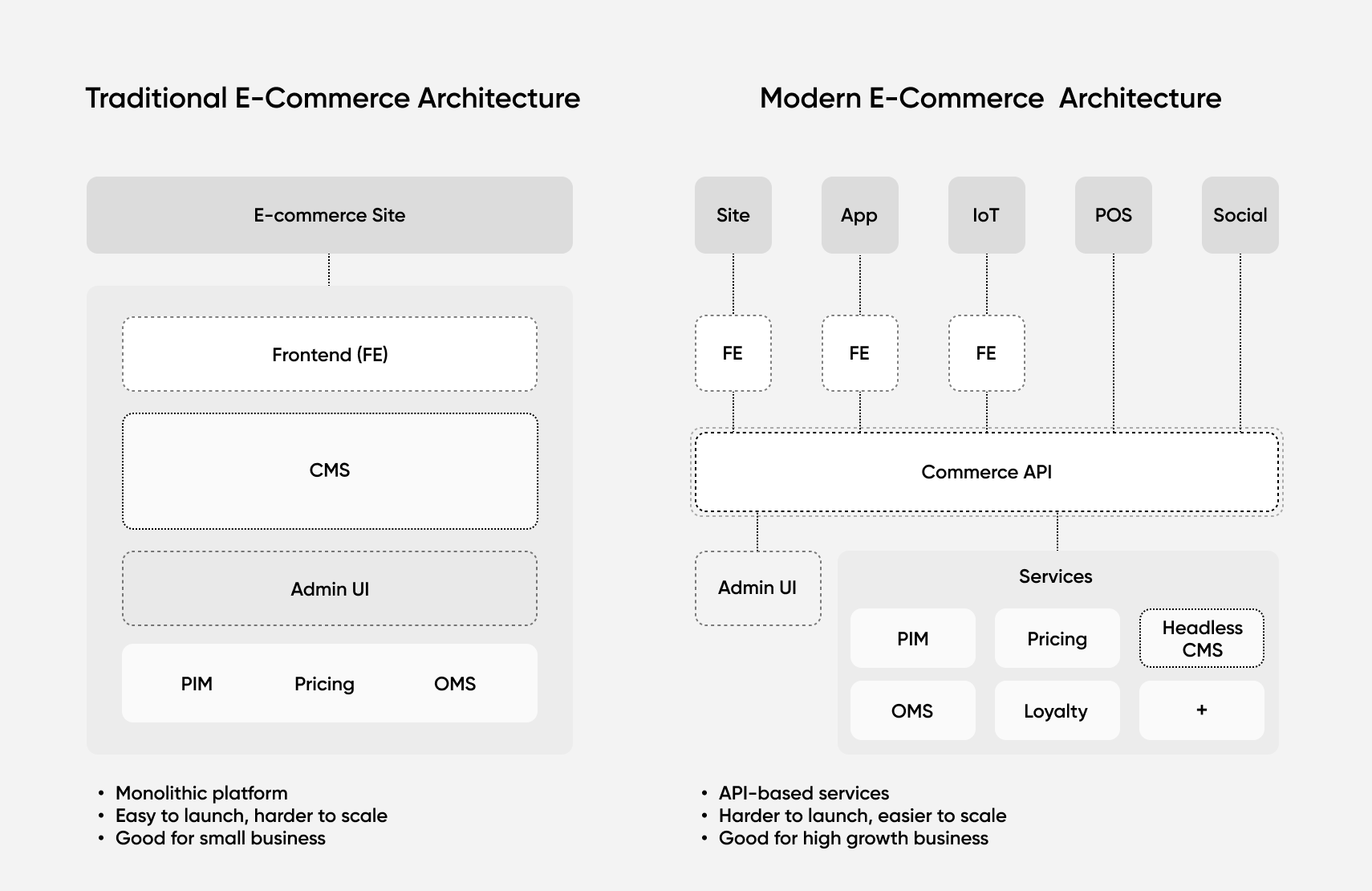
Traditional e-commerce and modern headless commerce are two different approaches to building and managing commerce platforms.
Traditional e-commerce and modern headless commerce are two different approaches to building and managing commerce platforms. Here are several distinct ways the two differ:
Frontend presentation layer and backend functions
In a headless commerce architecture, the presentation layer (frontend) and backend are decoupled, so any changes to inventory, order, pricing, promotions, and payments can be made independently from the frontend user interface and vice versa. Additionally, developers can leverage modern technologies and frameworks to build unique, visually appealing, and highly interactive storefronts that align with the brand’s identity and customer preferences. Ultimately, this can allow for more flexibility, customization, and scalability across devices and channels.
In a traditional monolithic e-commerce setup, the presentation layer and the backend are tightly coupled. Because backend functions are tightly integrated, this can simplify operations, but it may limit the choice of specialized solutions. Additionally, traditional e-commerce platforms often provide predefined templates and layouts, limiting options for frontend design. Customizing the user interface can be challenging, meaning that any frontend changes usually require backend modifications, which may slow development time and require extensive work.
Omnichannel experience
Headless commerce is suited to provide a consistent buying experience across channels—the same content is pulled from a headless CMS and pushed to websites, mobile apps, IoT devices, and other touchpoints in the correct format. Additionally, headless commerce can help deliver omnichannel fulfillment experiences using a modern distributed order management system.
Brands with a traditional e-commerce platform may struggle to deliver a seamless omnichannel experience; adjustments to accommodate different channels impact underlying backend systems, which may cause inconsistent customer experiences.
Scalability and performance
Because the frontend and backend systems are separated in a headless architecture, they can be independently scaled based on demand, ensuring better performance during peak periods with increased traffic or higher transaction volumes.
Scaling traditional e-commerce platforms can be complex and costly. As your business grows, you may encounter limitations in terms of traffic handling and system performance. Adjustments or upgrades to traditional e-commerce platforms may require major changes to the entire platform and other systems they may be integrated with, which can be challenging and may require significant downtime.
Development speed
While initial setup of a headless commerce system may require more effort, development speed often accelerates in the long run. Developers can work with the latest tools and technologies, rapidly prototyping and deploying new features or channels. This agility can lead to faster innovation and adaptation to changing market trends.
Getting started with traditional e-commerce platforms can be quicker since many features are pre-integrated. However, making customizations or adding new functionality may slow down development due to platform limitations.
Headless Commerce Examples
Many brands have leveraged headless commerce to great success. Retailers of all types and sizes can benefit from going headless, with use cases including marketplaces, D2C companies, and B2B companies. Here are two examples of how headless commerce can transform go-to-market strategies for retailers.
GNC
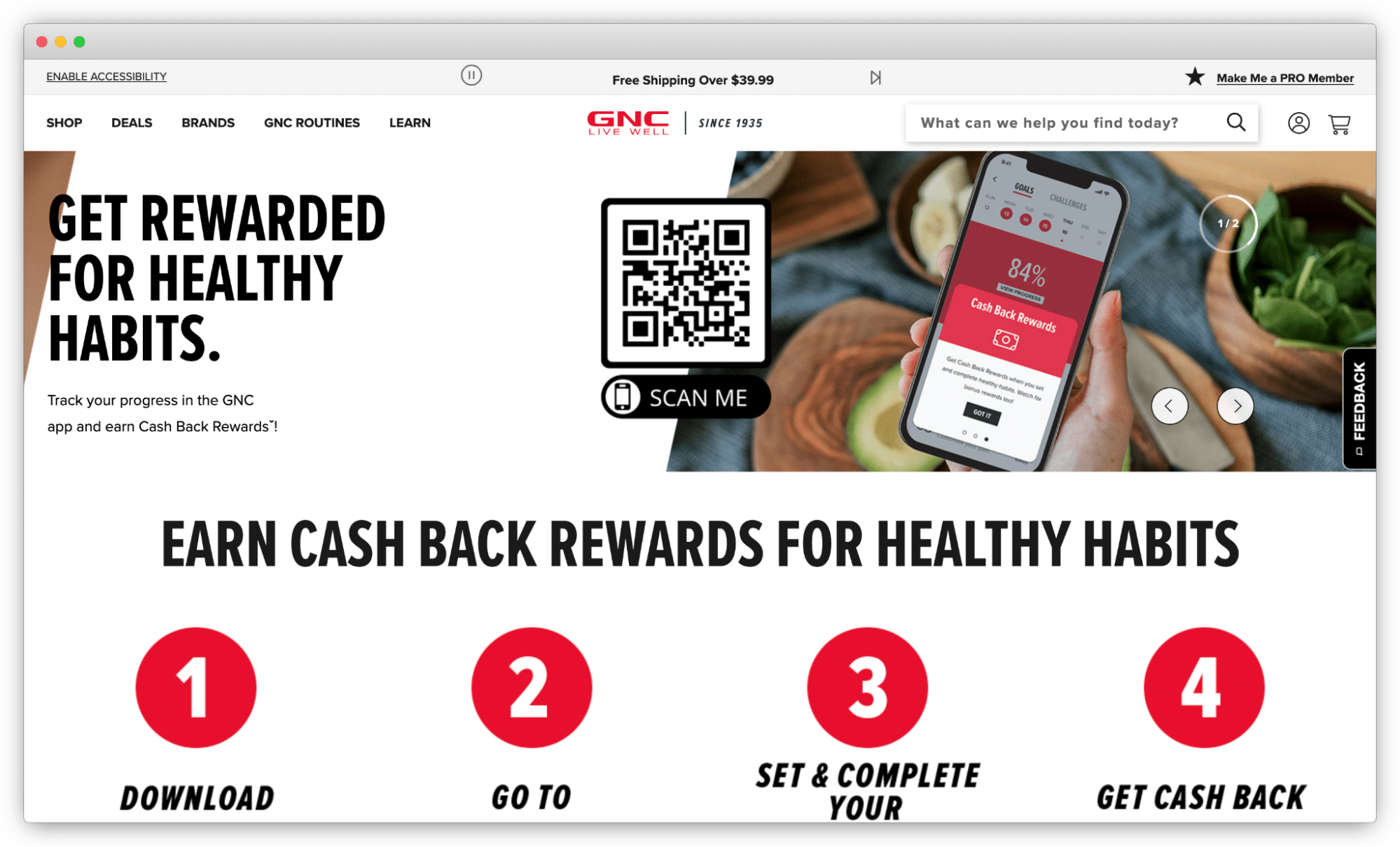
fabric’s agile approach and expertise in headless architecture allowed GNC to develop a future-proofed mobile app within a tight timeframe.
GNC is a global leader in the health and wellness industry, renowned for its extensive range of nutritional supplements and wellness products. The company was early to recognize the importance of a mobile-friendly e-commerce strategy and initially built a mobile e-commerce application that was extensively tailored to suit its needs. However, the app was highly customized, slow to progress, and the coding language it was built on was outdated and unsustainable. It was not sufficient to meet GNC’s needs and serve its consumers adequately.
But the company was confident that a mobile e-commerce app based on a headless e-commerce architecture would give them a competitive edge, allowing them to engage with a wider demographic, build stronger loyalty, and personalize the customer experience.
fabric partnered with GNC to overcome its mobile app challenges. fabric’s agile approach and expertise in headless architecture allowed them to develop a future-proofed mobile app within a tight timeframe. By leveraging existing code and integrating GNC’s systems, fabric delivered a fully-functional app in just 12 weeks, meeting GNC’s aggressive deadline.
Post-launch, GNC’s app crash rate went down by 75% and app improvements gained the company nearly 40,000 new Android customers. Overall, GNC grew its mobile active user count by 23% and considerably improved its app store ratings. By offering a one-stop shop to all of their customers—regardless of sales channel—GNC increased overall revenue by 55%.
Chico’s FAS
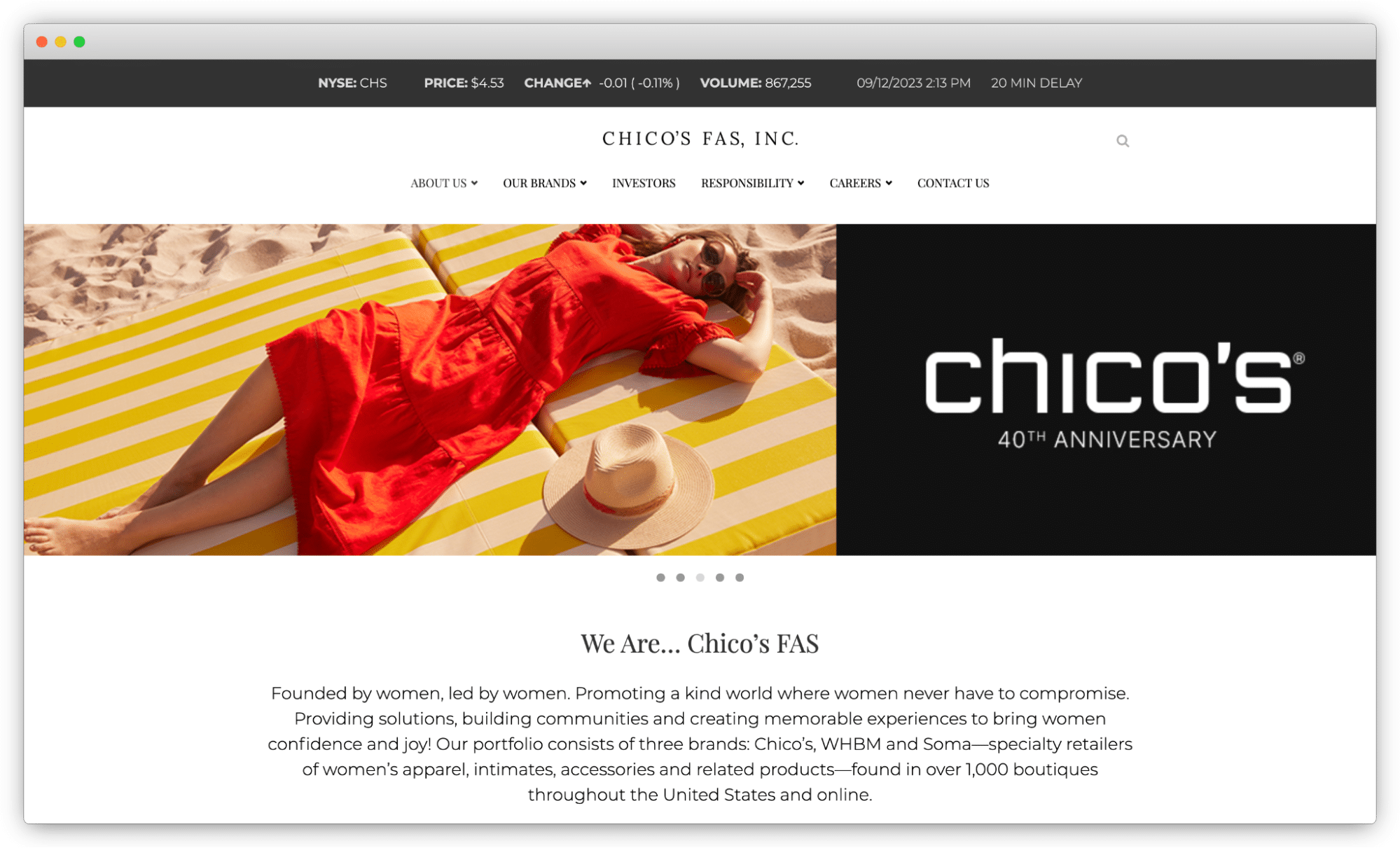
fabric’s headless commerce platform gave Chico’s more flexibility and empowers them to scale their brands to new heights—all with a lower total cost of ownership (TCO) over the long term.
In 2022, Chico’s FAS launched an initiative to modernize their consumer experience, expanding their digital presence on all channels for its brands, which include Chico’s, White House Black Market (WHBM), and Soma.
The company’s legacy tech stack was making it tough to create exceptional, customer-centric experiences. They needed what they called a “Connected Commerce” platform, with a flexible Commerce Technology Platform that could power their growth and sustain it over time.
Choosing fabric checked all the boxes. fabric’s platform would give Chico’s more flexibility and would empower them to scale their brands to new heights—all with a lower total cost of ownership (TCO) over the long term.
“Chico’s selected fabric because of the modular architecture. We don’t want to rip and replace in years to come. We want simplicity, we want to be API-driven, and we want to mix and match between different vendors. This e-commerce platform we are building will make us more nimble and agile, and it will be able to serve our business.”
-
Deepak Lakshmanan, VP, eCommerce Engineering at Chico’s FAS
5 Headless Commerce Platforms for E-Commerce Retailers
The software you use can have a major impact on your headless journey. Begin your vendor evaluation by reviewing the pros and cons of some of the leading headless commerce platforms available today.
fabric Commerce Platform
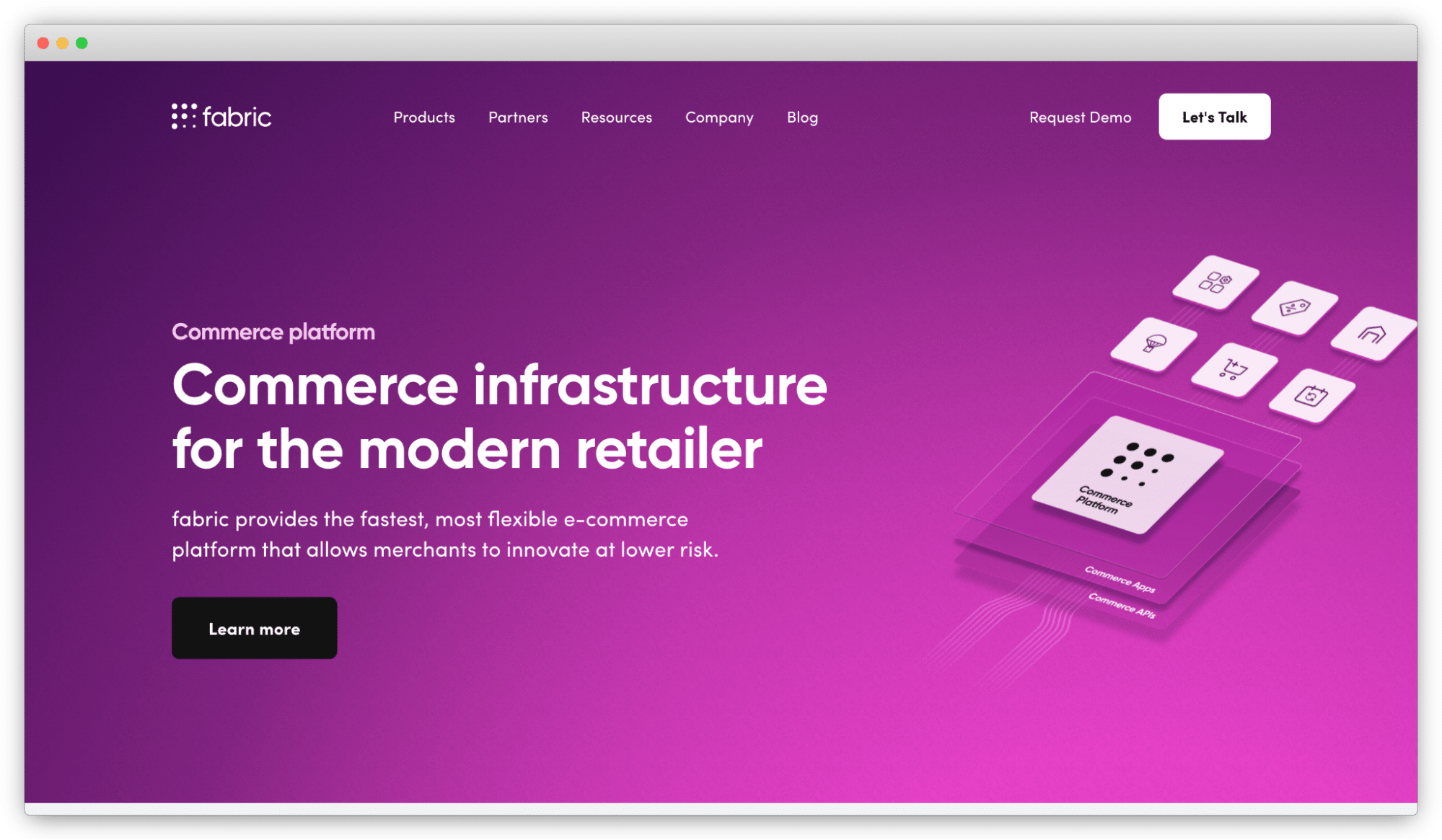
fabric offers a modular approach to e-commerce.
fabric’s headless and modular technology was created by e-commerce pioneers to serve top-tier e-commerce retailers. fabric offers a comprehensive, cloud-native headless solution that serves as a robust foundation for crafting the modern shopping experiences for today’s consumers.
fabric’s fully-composable and extensible platform offers a comprehensive suite of commerce solutions and APIs. Products include a distributed order management system (OMS), a pricing and promotions engine (Offers), a product information management system (PIM), as well as a dropshipping marketplace platform (Dropship). Customers like SNIPES, GNC, and brooklinen trust fabric to help deliver unparalleled shopping experiences to their customers.
Shopify Plus
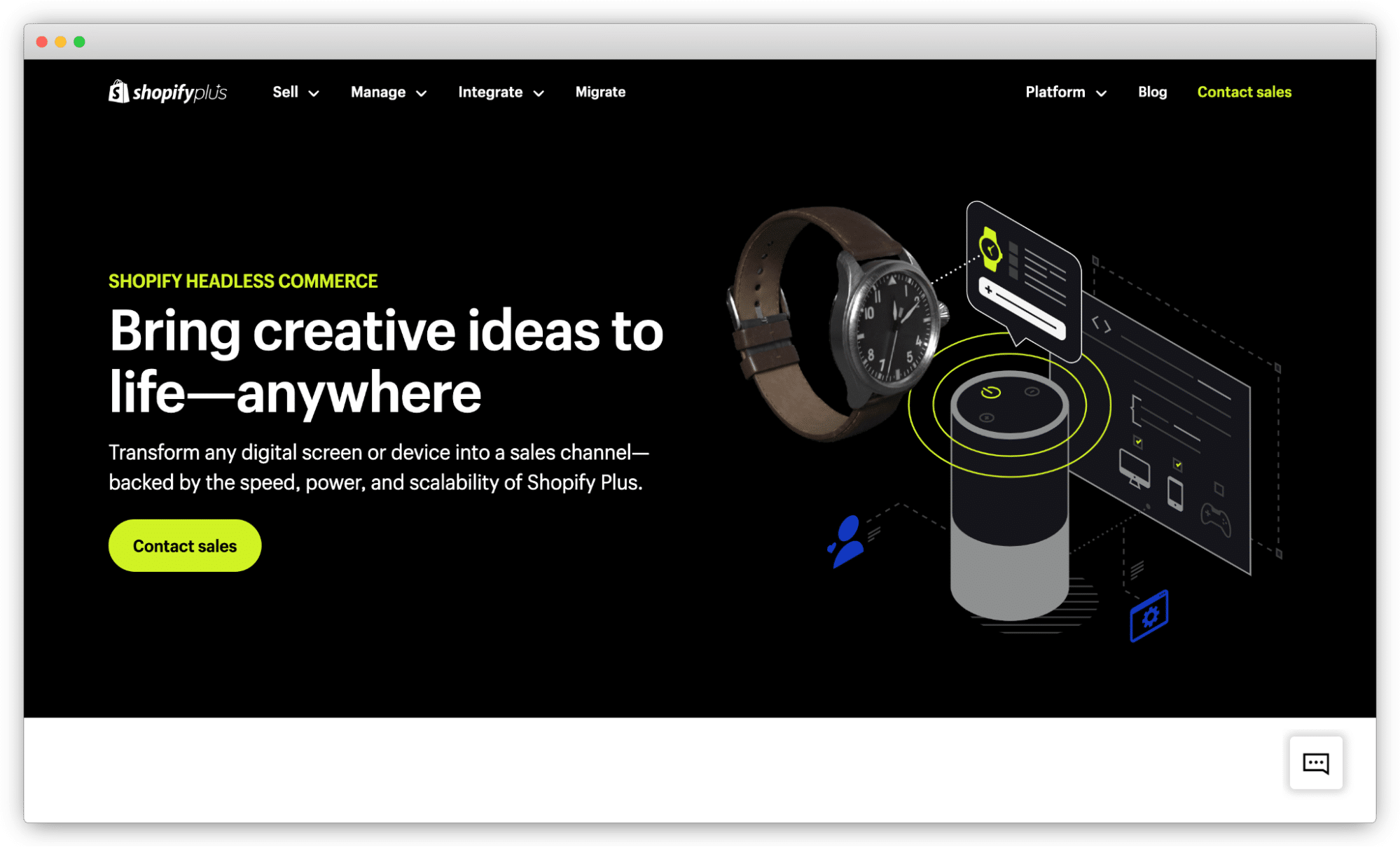
Shopify Plus offers a headless e-commerce platform best suited for small businesses.
Shopify Plus empowers brands to create digital storefronts on any device, backed by Shopify’s speed and scalability. It separates back-end infrastructure from front-end customer interactions, providing more control over buyer experiences. Developers enjoy freedom, using familiar tools and built-in Shopify resources to accelerate development while maintaining flexibility in visual expression and buyer experience.
Shopify’s headless approach empowers businesses to create unique commerce solutions while maintaining control and efficiency. However, Shopify Plus is not the strongest platform for enterprise e-commerce brands with complex business models.
Adobe Commerce (Magento)
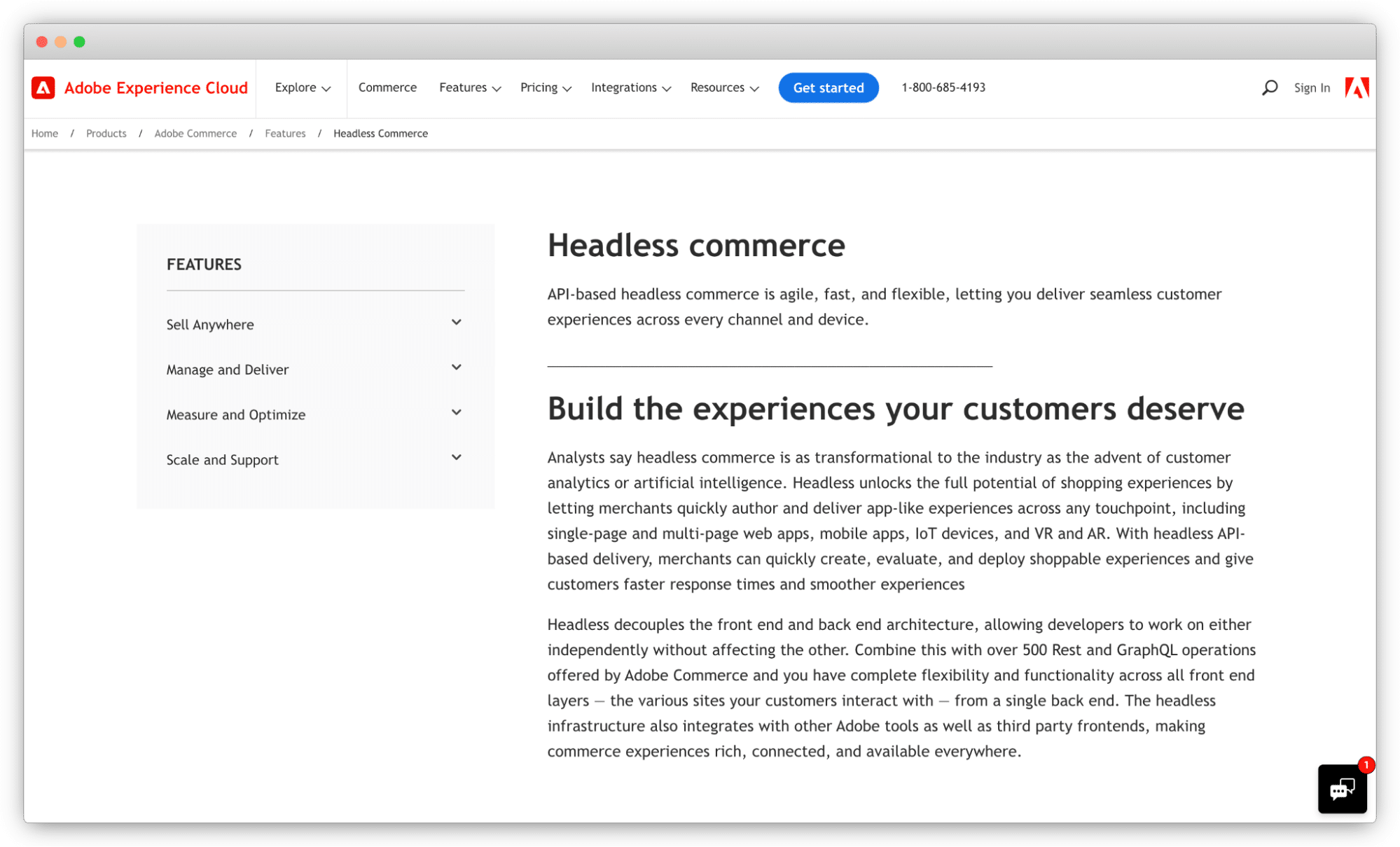
Adobe Commerce offers a headless solution, but you’ll need a team of developers familiar with various coding languages to work with it.
Adobe Commerce, otherwise known as Magento, has an API-based headless architecture to handle and process customer, order, and product information separately from the customer-facing part of an e-commerce site. In Adobe’s headless architecture, decoupled layers communicate via REST or GraphQL APIs, enabling you to build your own frontend or use a frontend-as-a-service (FaaS) platform.
If you’re developing your frontend in-house, you need developers familiar with Progressive Web App (PWA) technology. And if you’re still on Magento 1, your engineering team will have to upgrade to version 2.3 before they can start frontend work.
BigCommerce
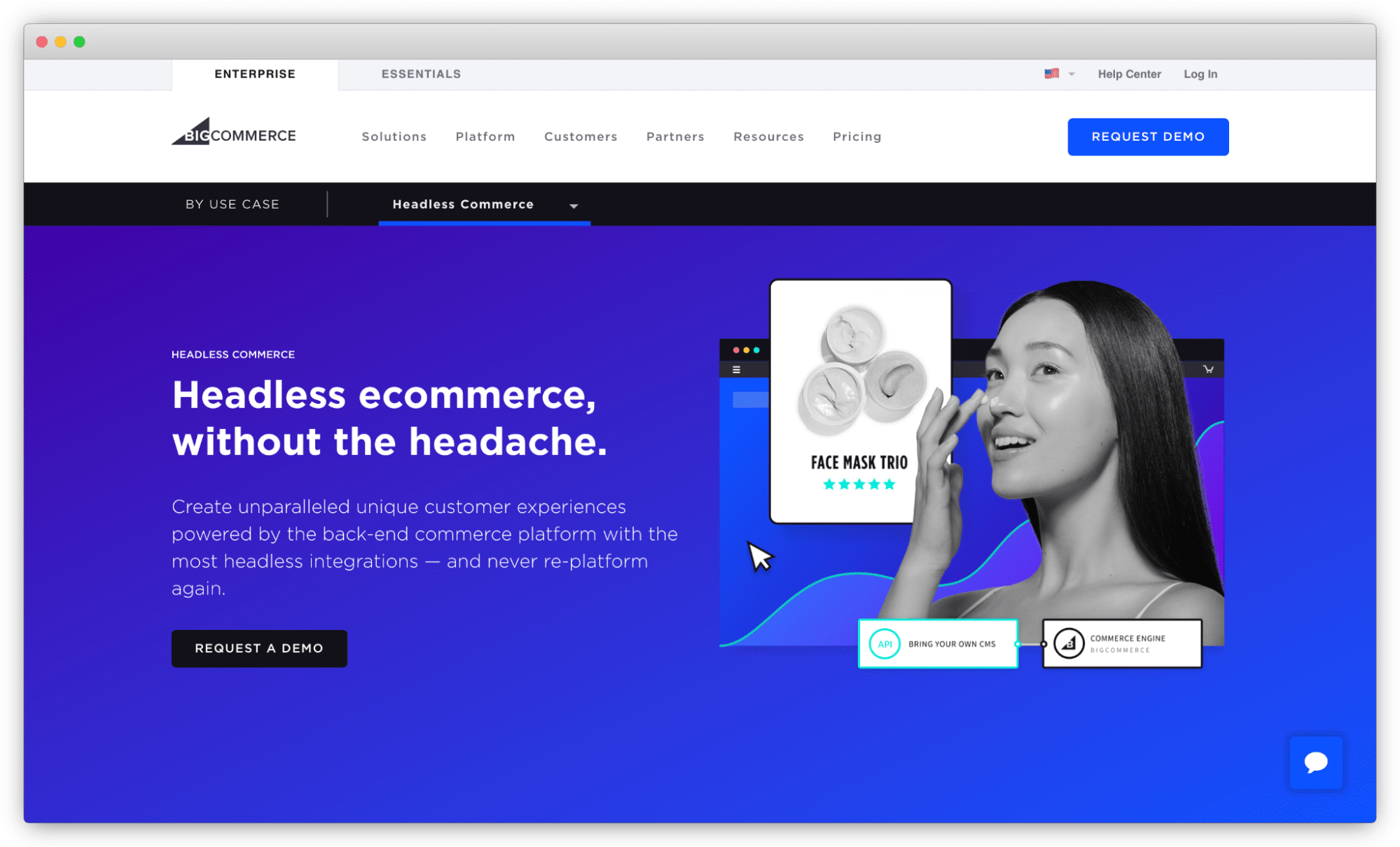
BigCommerce is a good headless option for small and mid-sized businesses. However, it lacks some critical features for enterprise.
BigCommerce is a headless commerce solution that empowers businesses to create unique and high-performance customer experiences. It offers flexibility by supporting various front-end frameworks and content management systems, allowing businesses to choose what works best for them. With API-first architecture and robust documentation, developers can easily build headless storefronts tailored to their needs.
BigCommerce is a great option for the small and midsize business (SMB) segment. However, the platform lacks some core commerce functions for enterprise businesses.
Salesforce Commerce Cloud
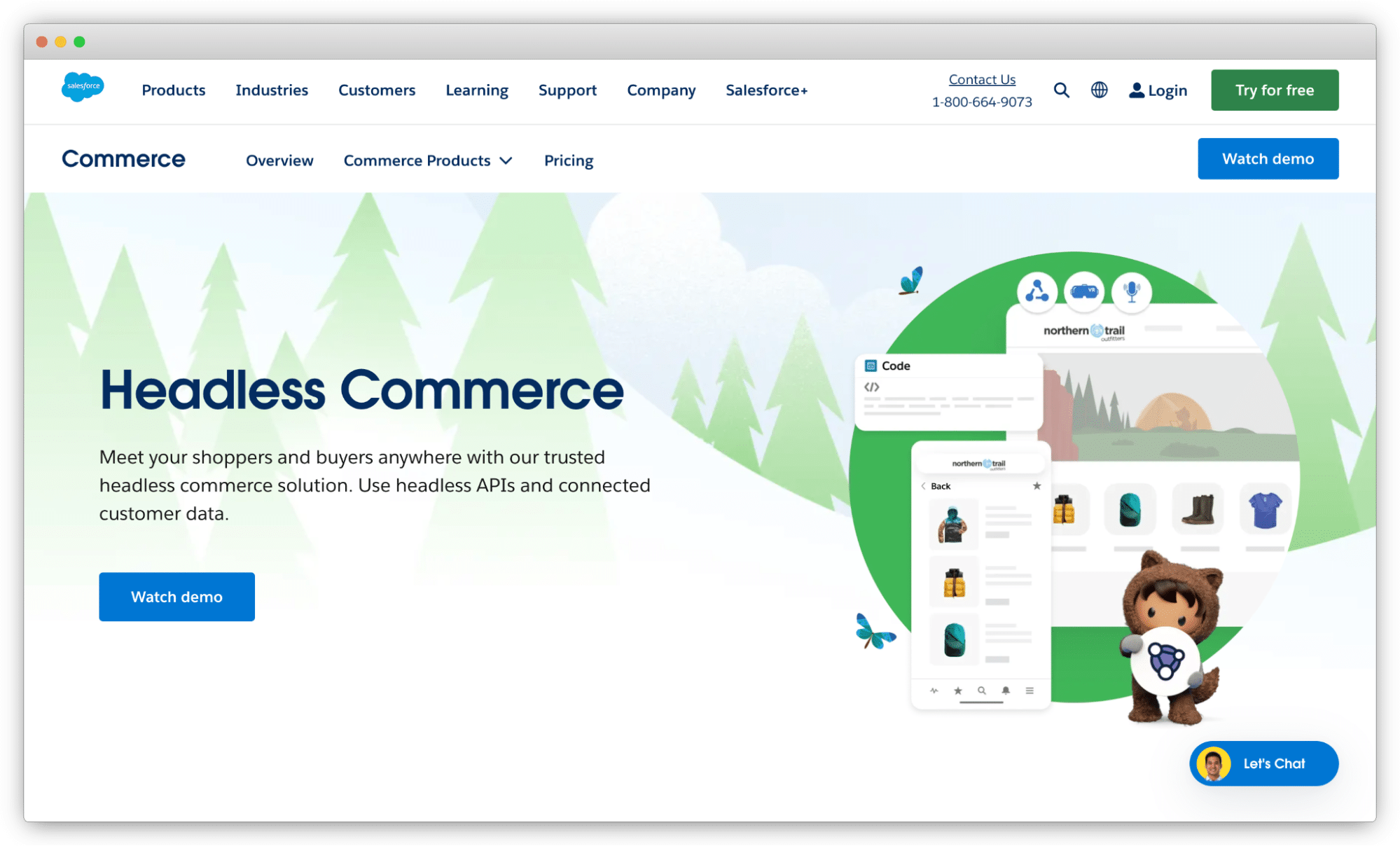
Salesforce Headless Commerce may be a good option for Salesforce shops with strong developer support. Developers must be familiar with PWA and Managed Runtime, frameworks used to design, deploy, and host Salesforce Commerce digital storefronts.
Salesforce headless commerce combines Salesforce’s existing Commerce Cloud with Mulesoft’s API capabilities to create a multi-tenant, cloud-based commerce architecture. Salesforce headless commerce customers benefit from their overall focus on AI, giving retailer marketers access to Einstein GPT, order automation with Salesforce Flow, and machine learning (ML) powered promotion management features. Salesforce also offers headless solution kits and training through Trailhead, and other headless resources via the Salesforce Developer Center.
To succeed with Salesforce Headless Commerce, developers must be familiar with PWA and Managed Runtime, frameworks used to design, deploy, and host Salesforce Commerce digital storefronts. Also, developers most familiar with Salesforce tend to have worked in a B2B capacity and may have a learning curve for B2C-led e-commerce.
How to Get Started With Headless Commerce
“Going headless” can be a game-changer, but it can also be challenging. Breaking down the process into manageable steps can help businesses get started on this journey successfully:
1. Define your goals
Before diving into the technical aspects, it’s crucial to establish a clear set of goals for a headless commerce strategy. Here are key considerations:
- Target Channels: Determine the channels you intend to reach, such as web, mobile, voice assistants, in-store kiosks, or any other touchpoints.
- Audience and Expectations: Identify your target audience and understand their expectations throughout the buying process.
- User Experience: Define the kind of user experience you aim to deliver. Consider looking at examples from other successful e-commerce companies for inspiration.
- Integration Requirements: Identify the internal systems that need to be integrated with your headless platform. This may involve retiring old systems and adopting new services.
- Scalability and Growth Objectives: Define your scalability goals and growth objectives. Your headless solution should evolve and grow with your business and should be flexible enough to handle spikes in traffic, expanded product lines, and entrance into new markets.
Additionally, assess your technical resources and consider whether partnering with a systems integrator or other partner would be beneficial.
2. Select the right headless commerce platform
Select a suitable headless commerce platform that aligns with your goals. Solutions that have pre-built core commerce capabilities such as order management, product information management, pricing and promotions, and dropshipping should be prioritized. There are several powerful options available, each with its unique features and capabilities, such as fabric Commerce Platform, Magento, Salesforce Commerce Cloud, Shopify Plus, and BigCommerce.
Here are some key criteria to consider:
- Modular Architecture: Prioritize platforms that offer a cloud-native and modular architecture, enabling flexibility and scalability.
- Frontend Framework Support: Ensure that the platform supports multiple frontend frameworks, or at least the one preferred by your development team.
- Prebuilt APIs: Look for platforms that provide pre-built APIs for most of your backend e-commerce services, streamlining integration efforts.
- Admin Experience: Opt for a platform with an intuitive admin interface that simplifies management tasks.
Retailers should also prioritize security by choosing a headless platform with SOC2 and PCI certifications to safeguard product, customer, and supplier data.
3. Design your frontend
With the backend and frontend decoupled, you gain the freedom to design a user-centric frontend that delivers exceptional user experiences. There are plenty of software options to help you accelerate your frontend development. You can start by creating a responsive design that adapts to various devices and screen sizes, emphasizing a mobile-first approach due to the prevalence of mobile shopping.
Personalization plays a crucial role as well. Utilize data and analytics to tailor product recommendations, content, and promotions to individual customers, enhancing both the shopping experience and conversion rates.
Ensure that your frontend prioritizes speed and performance. Slow-loading pages can deter potential customers. Implement optimization techniques like lazy loading and content delivery networks (CDNs) to expedite page load times.
4. Integrate and test
Businesses want to seamlessly connect frontend and backend systems through well-designed APIs. This integration is the backbone of any headless commerce architecture, ensuring that data flows smoothly between the customer-facing frontend and the backend systems. Integrations can leverage the power of third-party tools and services for vital functions such as payment processing and marketing automation as well.
To optimize the user experience, businesses should also conduct comprehensive testing. This should include:
- Testing for functionality and cross-device compatibility.
- Testing for usability with real users to gather feedback and make improvements.
By following these four steps, you can embark on your headless commerce journey with a well-defined strategy, the right technology stack, and a commitment to delivering an exceptional user experience.
Conclusion
The limitations of monolithic solutions can stifle a brand’s potential for growth and innovation. Embracing a headless and modular platform represents a strategic shift towards a more agile and customer-centric approach.
fabric Commerce Platform is a configurable and composable headless commerce solution, offering retailers the agility they need to swiftly adapt to changing market conditions and customer expectations. By harnessing the platform’s versatile management tools and robust e-commerce APIs, brands gain the power to create and scale unique shopping experiences seamlessly. With fabric PIM, fabric OMS, and fabric Offers at their disposal, companies can efficiently manage crucial aspects like product information, order fulfillment, inventory, pricing, and promotions across all their sales channels.
fabric Commerce Platform empowers brands to excel, enabling them to meet and exceed the evolving demands of modern consumers while staying ahead of the competition.
Headless Commerce FAQs
What is a headless approach?
A headless approach to commerce involves decoupling an e-commerce site’s frontend from its backend. Headless architectures give brands more freedom to customize presentation layers (what customers see) yet still access core commerce functions like product, orders, pricing, cart & checkout on the backend. With headless, retailers can more easily adopt an omnichannel sales strategy, creating memorable experiences on every channel—without incurring significant technical debt.
Is switching to headless commerce worth it?
While migrating from a traditional monolithic e-commerce platform to a headless platform can be a substantial undertaking, the benefits can outweigh the costs.
An API-first headless and modular platform can make backend development easier with API-driven integrations. Developers gain the flexibility to adjust site components, build new integrations, or deploy security updates with minimal risk and downtime.
Importantly, headless e-commerce also facilitates omnichannel sales—the direction consumers are pushing the retail industry. With headless, retailers can tailor the frontend of every brand across every channel, enabling unique and seamless buying experiences.
What’s the difference between a headless CMS and headless commerce?
A headless CMS is a content management system that separates content creation and management from its presentation, allowing content to be distributed across different digital channels and devices. A headless CMS is part of a headless commerce approach, which deals specifically with e-commerce operations, separating the backend commerce processes from the frontend user interfaces. This provides flexibility in designing unique customer experiences for online shopping.

Digital content editorial team @ fabric.